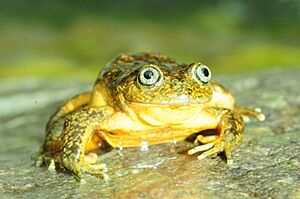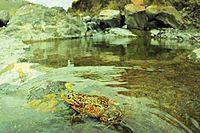Andean Water Frog facts for kids
Quick facts for kids Andean Water Frog |
|
|---|---|
 |
|
| Holotype male from Huaytará Province in 2012 | |
| Conservation status | |
| Scientific classification |
The Andean Water Frog, officially known as Telmatobius ventriflavum, is a special type of water frog. You can find these frogs in the western Andes mountains of Peru.
Contents
What's in a Name?
The name ventriflavum comes from two Latin words. 'Venter' means 'belly', and 'flavus' means 'yellow'. So, the frog's name tells you about its yellow belly!
How This Frog Was Found
Scientists found these frogs in October 2012. They were doing a survey for the Smithsonian Conservation Biology Institute. In February 2015, they officially announced it as a new species. They wrote about it in a science magazine called ZooKeys.
Finding this frog was a bit of a surprise! This area doesn't usually have many different species. There were already two other Telmatobius frogs nearby. One was about 200 kilometres (120 mi) north, and another 170 kilometres (110 mi) south. Also, the place where they found it was easy to get to. It was close to a main highway in Peru.
What the Andean Water Frog Looks Like
These frogs have a slender body. Female frogs are usually 49.3–55.7 millimetres (1.94–2.19 in) long. They weigh between 11.5–19.7 grams (0.41–0.69 oz). Males are about 48.5 millimetres (1.91 in) long and weigh around 13.6 grams (0.48 oz).
Their head is flat and wider than it is long. It makes up about 30% of their body length. They have large eyes and a rounded snout. Their tongue is also rounded, and they don't have vocal slits to make sounds.
The Andean Water Frog does not have webbing on its fingers. But it does have webbing on its toes. Its skin is smooth on both its belly and its back. However, its back has tiny bumps, like miniature pustules.
The color on their back can be light golden-yellow or golden-tan. It often has dark brown, golden-yellow, and red spots. Their sides are tan-yellow. This color fades into golden-yellow or marigold on their throat and belly. They have lighter areas on their chest.
The color of their legs is different for males and females. Males have bright marigold or orange legs on their underside. Females usually have golden-yellow or light marigold legs. These frogs also have thin turquoise rings around their eyes. Their eyes are light grey.
Where the Andean Water Frog Lives
You can find this frog high up in the Andes mountains of Peru. They live at elevations of about 3,900 metres (12,800 ft), and possibly up to 4,300 metres (14,100 ft). They are found on the western side of the mountains.
So far, scientists have only found them in one place. This is a stream that flows into the Huaytará river. This river then joins the Pisco river. The area around the stream is dry and open Puna grassland. Most of the rain there falls between January and March.
The frogs were found in a small stream, about 10 metres (33 ft) wide. This stream has parts with gravel and pebbles, like small pools. It also has small waterfalls and fast-flowing sections called riffles.
The dry environment around them limits where these frogs can go. This means they can't easily move to other places.
Reproduction and Life Cycle
Scientists believe these frogs breed for a long time. They found tadpoles at different stages of development. This suggests that the frogs might even breed during the dry season.
Threats to the Andean Water Frog
The place where T. ventriflavum lives is affected by a dam and a reservoir. This dam is about 500 metres (1,600 ft) downstream from where the frogs were first found. Building pipelines and roads also threaten their home. Water pollution from nearby mining and farming is another danger.
Scientists have also seen these frogs infected with a harmful fungus. It's called the chytrid fungus (Batrachochytrium dendrobatidis). This fungus causes a disease called chytridiomycosis. About 40% of adult frogs and 53.5% of tadpoles were infected.
This fungus has caused big problems for other Telmatobius frogs in South America. It has led to the disappearance of three species in Ecuador. It has also caused declines in frogs like T. marmoratus and T. timens in Peru. Three species in Argentina have also been affected. Other frogs like T. jelskii from Peru and T. gigas from Bolivia have also faced problems from this fungus.







